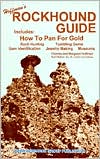

 |

|

The average rating for Rockhound Guide Includes How to Pan for Gold: Rock Hunting, Tumbling Gems, Gem Identification, Jewelry Making; Museums based on 2 reviews is 4.5 stars.
Review # 1 was written on 2016-07-15 00:00:00 Lisa Holland Lisa HollandTbh, I only very lightly skimmed it. But I surely did discover that if I had any excuse at all to buy my own copy, I would. Wonderfully and imaginatively organized. Includes not only life-forms, but weather (including clouds) and stars. Accessible, I believe, to the newbie, and also handy in the field to the wilderness guide. Interesting vertical design probably means there are more pockets and other caches that it can fit in, to be carried into the wilderness. Because, believe me, there are places you won't get a signal for your smart-phone! |
Review # 2 was written on 2017-08-26 00:00:00 Markus Biegel Markus BiegelI think this is just about the best field guide in the history of ever, and as a botanist, I own lots of them. No, it is not a comprehensive guide to every last organism in the Sierra Nevada (it's a pretty big mountain range). No, not every plant I encountered in the Sierras was in here. But it is an impeccably illustrated, pro-tip filled, and remarkably accessible and informative guide to this region of California. It's probably the next best thing to spending a couple months in the Sierras with a naturalist. Here's what I like about The Laws Field Guide to the Sierra Nevada: 1) Clear, full-color illustrations on every page that capture the gestalt of the organisms depicted. Illustrations are actually better than photographs because they allow the artist to draw the perfect model organism and highlight its important identifying features. This is actually a lot harder with photography, where things like lighting, weird angles, accessibility, and atypical forms are all problematic. Laws labels key traits in his illustrations that make identifying between lookalikes easier. 2) Simple, illustrated keys at the beginnings of sections. These are not advanced user keys, like the Jepson ones that have lines like, 'Calyx throat length 2-5 mm OR calyx throat length 5-8 mm' -- and you inevitably have a specimen that has a calyx length of 5 mm. Helpful, relatively unambiguous things like flower petal color, symmetry, petal number, etc. are used to guide the wildflower section. Then these take you to a page with pictures of all the organisms with those traits. There are also pages that compare and contrast easily confused genera, pages devoted to heterotrophic plants, and other slightly quirky but perfectly reasonable categories. 3) Cross-referencing. Some organisms appear more than once in the guide because they fall under multiple categories. Poison oak is in both shrub and vine categories - and who can deny that this is a sneakily variable plant that all Californians should probably learn? I think this was a pretty compassionate move. 4) Good coverage of almost all aspects of nature in the Sierras. I typically don't pay much attention to anything that isn't a plant (maaaaaybe a mushroom), but I've been cautiously leafing through the bird and mammal sections, and they offer really great tips for beginners (birds: pay attention to size, shape, posture, beak shape, chest and head patterns). There are sections on fish, fungi, amphibians, reptiles, and even constellations. I'll go there eventually. Maybe. When I'm done with all the plants. John Muir Laws knows a hell of a lot about the Sierra Nevada, and he has the artistic skills to depict it all in great detail. Seriously, I never go to the Sierras without this one, while Jepson languishes on my shelf. It would be so, so epic if Laws published a whole series like this on every other major California ecosystem, although that might take more than a lifetime to do. Note: a few of the scientific names have changed since this guide was published 10 years ago. It's inevitable. |
CAN'T FIND WHAT YOU'RE LOOKING FOR? CLICK HERE!!!